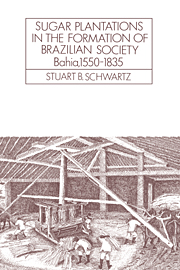Book contents
- Frontmatter
- Contents
- List of figures, maps, and tables
- Preface
- Abbreviations and special terms
- Weights and measures
- Dedication
- Part I Formations, 1500–1600
- Part II The Bahian engenhos and their world
- Part III Sugar society
- 9 A colonial slave society
- 10 The planters: masters of men and cane
- 11 The cane farmers
- 12 Wage workers in a slave economy
- 13 The Bahian slave population
- 14 The slave family and the limitations of slavery
- Part IV Reorientation and persistence, 1750–1835
- Appendixes
- Notes
- Glossary
- Sources and selected bibliography
- Sources of figures
- Index
- CAMBRIDGE LATIN AMERICAN STUDIES IN PRINT
14 - The slave family and the limitations of slavery
Published online by Cambridge University Press: 05 May 2010
- Frontmatter
- Contents
- List of figures, maps, and tables
- Preface
- Abbreviations and special terms
- Weights and measures
- Dedication
- Part I Formations, 1500–1600
- Part II The Bahian engenhos and their world
- Part III Sugar society
- 9 A colonial slave society
- 10 The planters: masters of men and cane
- 11 The cane farmers
- 12 Wage workers in a slave economy
- 13 The Bahian slave population
- 14 The slave family and the limitations of slavery
- Part IV Reorientation and persistence, 1750–1835
- Appendixes
- Notes
- Glossary
- Sources and selected bibliography
- Sources of figures
- Index
- CAMBRIDGE LATIN AMERICAN STUDIES IN PRINT
Summary
You, so-and-so, in your time you will marry what's her name.
André João Antonil (1710)… they are married before the Church, solemnly by words, André Gege with Eugenia Gege, Antônio Nagô with Rita Nagô, all slaves of Captain Antônio de Araújo Gomes, residents in this parish of Our Lady of Purification, and they then received the blessings according to the rites and ceremonies of Holy Mother Church.
Purificação parish register (1785)In the face of the deadly demography of Bahian slavery and the limitations imposed by the institution on the life choices and opportunities of those who lived within it, slaves sought to create social and cultural forms that provided solace and support in a hostile world. This chapter will look beyond the demographic structures to examine the cultural boundaries that defined opportunities and then examine the social responses of slaves constantly confronted by the power of the slaveholders. The formation of the family, especially through the sacrament of marriage, and the spiritual birth of the individual through the sacrament of baptism were two moments of extreme importance for anyone living in colonial Brazil, and much of my discussion will center on these acts. We must realize at the outset, however, that the formation of a conjugal unit and ultimately of a family did not depend on church-sponsored marriage for either slaves or free persons.
- Type
- Chapter
- Information
- Sugar Plantations in the Formation of Brazilian SocietyBahia, 1550–1835, pp. 379 - 412Publisher: Cambridge University PressPrint publication year: 1986



